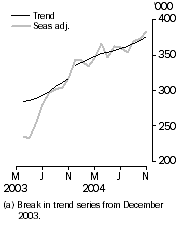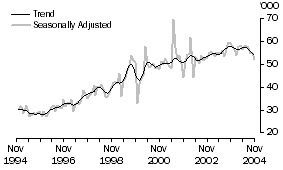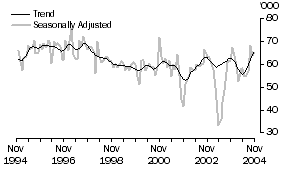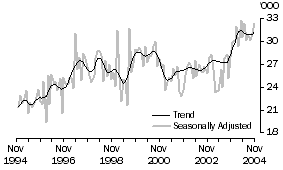NOVEMBER KEY FIGURES
 |  | Nov 04 | Oct 04 to Nov 04 | Nov 03 to Nov 04 |  |
 |  | '000 | % change | % change |  |
|  |
| Short-term visitor arrivals |  |  |  |  |
 | Trend | 444.0 | 0.6 | 4.0 |  |
 | Seasonally adjusted | 453.1 | 4.1 | . . |  |
 | Original | 479.9 | . . | . . |  |
| Short-term resident departures |  |  |  |  |
 | Trend | 376.2 | 1.4 | 18.8 |  |
 | Seasonally adjusted | 383.7 | 3.0 | . . |  |
 | Original | 338.6 | . . | . . |  |
|  |
| . . not applicable |
Visitor arrivals, Short-term

| Resident departures, Short-term

|
NOVEMBER KEY POINTS
TREND ESTIMATES
- The trend estimate for short-term visitor arrivals to Australia during November 2004 (444,000 movements) increased by 0.6% compared with October 2004. This followed monthly increases of 0.6% each for September and October 2004.
- Currently, short-term visitor arrivals are 4.0% higher than in November 2003 and 4.5% higher than when the series last troughed in March 2004 (424,900 movements).
- During November 2004, short-term resident departures (376,200 movements) increased by 1.4% compared with the previous month and followed increases of 1.1% for September and 1.2% for October 2004.
- Short-term resident departures have recorded steady growth over the past year. Compared with November 2003 (316,600 movements), short-term resident departures are up by 18.8% and up by 31.9% from when they last troughed in April 2003 (285,200 movements). These increases were affected by a break in the trend series.
SEASONALLY ADJUSTED ESTIMATES
- The seasonally adjusted estimate for short-term visitor arrivals during November 2004 (453,100 movements) increased by 4.1% compared with October 2004. Short-term visitor arrivals for September and October months were stable.
- Short-term resident departures for November 2004 (383,700 movements) increased by 3.0% compared with October 2004 and followed increases of 4.4% for September and 0.7% for October 2004.
ORIGINAL ESTIMATES
- In original movement terms, there were 479,900 short-term visitor arrivals to Australia and 338,600 short-term resident departures from Australia during November 2004.
NOTES
EARLY ESTIMATES
Early estimates of short-term visitor arrivals for December 2004 will be available on the Australian Bureau of Statistics (ABS) web site on 18 January 2005. These estimates can be accessed at Short-term Visitor Arrival Estimates, Australia (cat. no. 3401.0.55.001).
DATA NOTES
This publication contains movement data. Care should be taken when interpreting this movement data as 'people'. See paragraph 5 of the Explanatory Notes for more detail.
Calculations of percentage and numeric change are based on unrounded data. See paragraph 12 of the Explanatory Notes for more detail.
CHANGES IN THIS ISSUE
- This issue is the first release of this publication to only be as a Portable Document Format file (i.e. Adobe Acrobat .pdf format) on this site: select AusStats then Publications & Data and then Publications. The decision to cease pre-printed releases was made to make this monthly publication available at an earlier date.
- From this issue ABS has introduced an improved method for removing trading day effects from seasonally adjusted estimates. Please see paragraph 17 of the Explanatory Notes for further information.
FORTHCOMING CHANGES
New standard errors
A new set of standard errors will apply to sampled estimates in this publication from the January 2005 issue. This is because the sample for short-term movements has been increased as a result of a review, resulting in smaller standard errors. New standard errors will be presented in the Standard Errors section from the January 2005 issue.
EMERGING ISSUES
December 2004 Indian Ocean tsunami
The 26 December 2004 Indian Ocean earthquake and tsunami may impact on overseas visitor arrivals from, and resident departures to, affected countries. However, it is not possible as yet to gauge the magnitude of this impact or its duration. There may also be breaks in some trend series as a result of this event.
INQUIRIES
For further information about these and related statistics, contact the National Information and Referral Service on 1300 135 070 or Anne Ward on Canberra (02) 6252 6871.
MAIN FEATURES
SHORT-TERM VISITOR ARRIVALS
In trend terms, short-term visitor arrivals to Australia have increased by 4.0% since November 2003. Monthly increases have been recorded since April 2004 and since June 2004 the increase has been constant at 0.6% each month.
The following table presents the top ten source countries (based on original estimates) for short-term visitor arrivals during November 2004. Seasonally adjusted and trend estimates are also presented for these countries, along with the trend percentage change compared with October 2004 and November 2003.
Short-term Visitor Arrivals, Major Source Countries - November 2004 |
|  |
 | Trend | Seasonally Adjusted | Original | Oct 04 to Nov 04 | Nov 03 to Nov 04 |  |
 | '000 | '000 | '000 | Trend % change | Trend % change |  |
|  |
| New Zealand | 87.6 | 87.4 | 83.2 | -0.2 | 16.5 |  |
| Japan | 65.6 | 65.4 | 66.4 | 2.7 | 4.8 |  |
| United Kingdom | 53.8 | 52.0 | 64.9 | -1.6 | -7.1 |  |
| United States of America | 34.5 | 34.0 | 34.1 | -2.0 | -2.7 |  |
| Singapore | 22.4 | 23.7 | 34.0 | 2.9 | 2.2 |  |
| China | 22.3 | (a)np | 24.3 | 3.9 | 18.6 |  |
| Korea | 18.9 | 19.1 | 21.2 | 1.1 | 2.5 |  |
| Malaysia | 15.8 | 17.0 | 19.8 | 1.3 | 3.5 |  |
| Germany | 11.8 | 11.4 | 14.0 | - | - |  |
| Canada | 8.0 | 8.5 | 10.4 | -2.1 | 3.2 |  |
|  |
| - nil or rounded to zero (including null cells) |
| (a) Seasonally adjusted data for short-term visitor arrivals from China is of an unpublishable standard. |
SHORT-TERM RESIDENT DEPARTURES
In trend terms, short-term resident departures have increased by 18.8% between November 2003 and November 2004 and have recorded consecutive monthly increases during the period. However, this increase was affected by a break in the trend series in December 2003. See paragraph 22 of the Explanatory Notes linked to this Main Features.
The following table presents the top ten destinations (based on original estimates), for short-term resident departures during November 2004. Seasonally adjusted and trend estimates are also presented for these countries, along with the trend percentage change compared with October 2004 and November 2003.
Short-term Resident Departures, Major Destinations - November 2004 |
|  |
 | Trend | Seasonally Adjusted | Original | Oct 04 to Nov 04 | Nov 03 to Nov 04 |  |
 | '000 | '000 | '000 | Trend % change | Trend % change |  |
|  |
| New Zealand | 68.7 | 65.4 | 58.6 | 0.1 | 13.3 |  |
| United States of America | 31.0 | 32.1 | 29.4 | -0.1 | 18.2 |  |
| Indonesia | 26.2 | 29.5 | 24.5 | 1.2 | (a)np |  |
| United Kingdom | 31.3 | 32.3 | 20.4 | 0.9 | 10.9 |  |
| Hong Kong | 14.2 | 15.2 | 18.1 | 4.2 | 19.5 |  |
| Thailand | 16.7 | 17.0 | 16.2 | 3.6 | 14.7 |  |
| Fiji | 16.0 | 17.0 | 15.1 | 3.2 | 23.0 |  |
| China | 17.3 | 17.8 | 14.4 | 2.2 | 43.5 |  |
| Singapore | 14.2 | 15.0 | 14.2 | 2.6 | 12.5 |  |
| Malaysia | 13.5 | 16.4 | 13.0 | 6.2 | 21.5 |  |
|  |
| (a) Not available for publication, due to a break in the trend series from December 2003. See paragraph 22 of the Explanatory Notes linked to this Main Features. |
SHORT-TERM TRAVEL BETWEEN JAPAN AND AUSTRALIA
According to trend estimates, the number of short-term visitor arrivals from Japan represented 15% of all short-term visitor arrivals to Australia in November 2004. Recent trend estimates show that movements of short-term visitors from Japan have been increasing since June 2004 and are currently 5% higher than in November 2003.
In original terms, 82% of the Japanese visitors to Australia in November 2004 stated holiday as the main reason for journey, compared with 54% of all short-term visitor arrivals. The median age of Japanese visitors was 32 years (40 years for all visitors) and the median duration of stay was 6 days (10 days for all visitors).
JAPAN, Short-term Visitor Arrivals

Trend estimates show that the number of short-term residents departing Australia for Japan in November 2004 represented only 2% of all short-term resident departures. Since November 2001 the trend, while showing fluctuations, has been upwards. In October and November 2004 there were decreases in the number of departures to Japan indicating that these movements may have plateaued. Movements from November 2003 to November 2004 increased by 19%.
In original terms, 41% of Australian residents departing to Japan in November 2004 stated business as the main reason for journey while a further 20% stated holiday. Of all short-term resident departures, 18% stated business and 42% stated holiday.
JAPAN, Short-term Resident Departures

PERMANENT AND LONG-TERM MOVEMENTS
There were 9,470 permanent (settler) arrivals into Australia during November 2004, an increase of 8.4% when compared with November 2003 (8,740 movements). Settlers born in the United Kingdom accounted for the largest proportion (15%) followed by New Zealand (12%) and China (8%).
Statistics on overseas arrivals and departures relate to the number of movements of travellers rather than the number of travellers. Therefore, care should be taken when using long-term arrivals data as it is known some individuals who travel multiple times in a year are counted each time they cross Australia's borders (see paragraph 5 of the Explanatory Notes). Long-term arrivals in this publication are not an appropriate source of migration statistics. For further information refer to Australian Demographic Statistics (cat. no. 3101.0).
There were 4,600 Australian residents departing permanently from Australia during November 2004, an increase of 9% when compared with November 2003 (4,200 movements).
STATISTICAL SIGNIFICANCE
The above presentation of movements in estimates does not take into account whether the change in movement is statistically significant. Care should be taken when interpreting the impact of numeric and/or percentage change. For more detail please see the Standard Errors document linked to this Main Features.
SEASONALLY ADJUSTED AND TREND ESTIMATES
INTRODUCTION
Seasonally adjusted and trend estimates add to the understanding of Overseas Arrivals and Departures (OAD) statistics. Seasonally adjusted estimates allow users to analyse short-term movements including irregular impacts on the series, while trend estimates provide a better method to analyse and monitor the underlying direction of the short-term movement series. In most cases, the trend series is the best source of information on the long-term direction of these statistics.
SHORT-TERM VISITOR ARRIVALS
Selected Source Countries
The graphs presented below illustrate the impact of the 2003 Rugby World Cup on arrivals from the United Kingdom in the later half of 2003, and the significant impact of Severe Acute Respiratory Syndrome (SARS) on arrivals from Japan.
United Kingdom
 Japan
Japan

SHORT-TERM RESIDENT DEPARTURES
Selected destinations
The recent upward trend in departures of Australian residents to the United States of America appears to have peaked and has been in decline since July 2004. While departures to the United Kingdom appeared to be declining in recent months, trend figures for October and November 2004 are again showing an increase in movements.
United States of America
 United Kingdom
United Kingdom

 Print Page
Print Page
 Print All
Print All